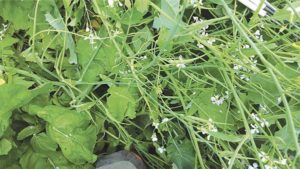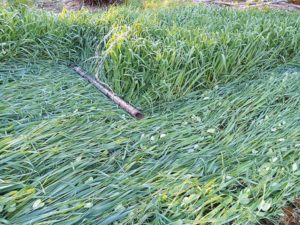 |
| A pasture seeded in a “crazy mix” consisting of over eight species of cover crops. Planted in the early summer, the tillage radish bolted and set seed instead of growing a large taproot – different species may perform better at different times of the year. Photo courtesy of Caleb Goossen |
 |
| Peas and oats can be knocked down to plant garlic into; the cover crops will winter-kill, becoming mulch for the garlic while also providing nitrogen. Goossen photo |
By Becky Maden & Caleb Goossen, Ph.D.
For farmers, and home growers with enough space and equipment to “go big” on cover cropping, cover crop mixes (aka “cover crop cocktails”) have grown in trendiness. However, you can spend a lot of money purchasing pre-made mixes without really knowing why you are planting so many species at once. The benefits of combining winter rye with hairy vetch, or oats with field peas, are familiar: The legume fixes nitrogen while the grass adds biomass (carbon), suppresses weeds and acts as a nurse crop for the legume; essentially you get the benefits from both species at the same time. What happens if you add more species to the mix? Do the benefits multiply?
Benefits of Cover Crop Cocktails
Planting a large number of cover crop species can provide easy-to-see benefits to the grower. Namely, if you plant many species, at least one of them should perform ok regardless of the land’s specific conditions and that year’s weather. Mixes offer opportunities to trial cover crop species that you may not have had the courage to purchase by themselves and also to make use of leftover cover crop seed – simply pour together whatever seed you have kicking around, plant it and witness what does well.
The benefits of a cover crop cocktail may not justify the additional cost, however, when a simple or self-made mix might meet your needs just as well. Consider each cover crop species within a mix as an investment and the benefits that your land and the broader environment receives from each species as the return on that investment. It’s easy to see the benefits in moving from growing zero cover crops to planting one cover crop species. Adding another species that has different characteristics than the first species will likewise give you an easily noticed return on your investment. For example, when you add peas to oats, you’re also adding the benefit of nitrogen fixation. However, the peas don’t add much of a benefit in terms of biomass as oats produce plenty of biomass on their own.
Adding a third species can provide another benefit beyond what the peas or oats can provide – tillage radish (aka daikon), with its deep tap roots, can break up soil compaction. A fourth species could be added: perhaps buckwheat because it establishes very quickly and is known for shading out weeds. However, as you continue to add species to the mix, the sum of cover cropping benefits – your overall return on investment – may only increase a little bit. That’s partially because the first few species are already providing many of the benefits that any cover crop can provide (i.e., living roots, biomass creation, etc.). Moreover, as you continue to add species, the mix gets diluted and the overall impact of any one of the species’ benefits decreases. This declining overall return on investment likely isn’t very noticeable with just three species, but the marginal gains that each new species adds will continue to be harder to observe. That said, this isn’t meant to discourage anyone from experimenting with or regularly using diverse cover crop mixes – by all means have fun with your cover cropping!
Sowing Your Mix
When it comes to planting cover crop cocktails, there are some fundamentals that you’ll want to follow. You’ll need to carefully consider the growth period for the mix. Is this a multi-season mix? Do you need to plant an early crop on the same field the following spring? Can the subsequent crop tolerate high amounts of cover crop residue? Is your subsequent crop a heavy feeder? Was the field weedy the previous season? You might stagger the benefits of your cover crop mix. For instance, a summer-planted mix consisting of sorghum sudangrass, Japanese millet and red clover builds biomass during the first summer, but the nitrogen-fixing red clover becomes dominant the following spring once the grasses are mowed and winter-killed. Alternatively, you might choose to plant a mix that matures and is terminated all at the same time – like a fall-planted rye (or wheat, or triticale) and vetch mix.
If you are new to cover crop mixes, long rotations may provide the best opportunity for more diverse and more complicated mixes to really shine. In allowing a field to remain in cover crop for a longer period of time, the different species in the mix each have a turn to flourish. This is particularly true with mixes containing both short- and long-lived species. Fast-growing annual species establish themselves quickly and can act as a nurse crop for long-lived species that are often small-seeded and slow to get going – provided that the annuals aren’t so competitive that they shade out the longer-lived species.
For seeding, the general rule of thumb is to keep legume seeding rates the same as if planting them by themselves and to reduce grass seeding rates by 25-50% of their individual seeding rate. Ideally you would seed everything in the mix at the correct depth for that seed type to ensure good germination rates, but this may be difficult with your equipment or on your scale. You can shoot for the average depth required by all the species in the mix, or you could split the seed mix into two batches by seed size – large and small – and make two separate passes. (Note that a mix of seed types might self-separate by size, with smaller seeds falling to the bottom – frequent mixing may be advisable when planting all at once.) Another strategy is to seed different species in separate, neighboring rows. Very small seeds, like clover, can even be broadcast before a good rain. Another way to plant cover crop mixes is to temporally separate your seeding dates. For instance, some growers utilize frost seeding to establish red clover in a pre-existing field of winter rye. The clover is broadcast during the freeze-thaw cycles of late winter, and the seeds work their way into cracks in the soil. The following spring the mature rye can be harvested for straw, leaving behind an established understory of clover – which, in turn, can provide an incredible amount of nitrogen for a late summer crop.
So have fun out there – mix it up! If you want to play with simple cover crop mixes, or complicated ones, you can start with MOFGA Fact Sheet #10: Using Green Manures, Penn State Extension’s Making the Most of Mixtures Guide or “Managing Cover Crops Profitably.” There is also a fantastic SARE presentation on cover crop cocktails by Mitch Hunter and Charlie White, of Penn State, that can be found at: https://www.sare.org/resources/cover-crop-cocktails/.
About the authors: Becky Maden works with the University of Vermont Cooperative Extension. Caleb Goossen, Ph.D., is MOFGA’s organic crop and conservation specialist. You can contact him at [email protected].
